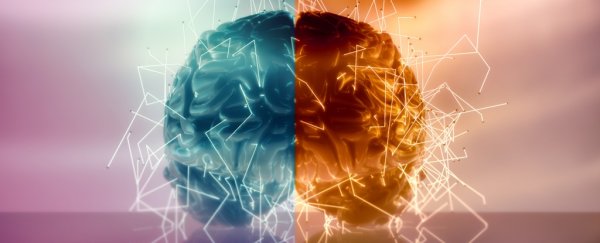We're usually told that the left side of the brain controls the right side of the body, and vice versa, but new research shows there's a lot more to it than that.
For decades, scientists have been finding evidence in both animals and humans to suggest that it's not just the contralateral (opposing side) brain hemisphere that plays a role in body movement, but also the ipsilateral (same side) hemisphere.
As it stands, though, the extent to which the ipsilateral brain hemisphere helps regulate movement in limbs and digits on the same, shared side of the body has never been well understood. Now researchers have broken new ground in identifying the relationship between cortical activity and ipsilateral movement.
For the first time, researchers at Washington University in St. Louis have demonstrated that 3D arm movement kinematics – encompassing limb speed, velocity, and position – can be decoded from human electrocorticographic (ECoG) signals ipsilateral to the moving limb.
"These results clarify our understanding that the ipsilateral hemisphere robustly contributes to motor execution and supports that the information of complex movements is more bihemispherically represented in humans than has been previously understood," the authors write in their paper.
Before now, evidence of movement kinematics decoded from the ipsilateral hemisphere was relatively limited.
To go deeper, lead researcher and neuroscientists Eric C. Leuthardt recruited four epilepsy patients (three male, one female) undergoing a separate ECoG procedure to pinpoint the source of their condition.
With their brains implanted with ECoG electrodes – which could register their neural activity in both the left and right hemispheres of the brain – Leuthardt wanted to measure both contralateral and ipsilateral activity as the participants moved their arms around in a three-dimensional reaching exercise.
Using a machine learning algorithm to decode the neural signals, the researchers found that movement kinematics are distributed bilaterally across cortical hemispheres, with evidence of ipsilateral arm reaches being decoded with comparable accuracy to contralateral reaches.
The researchers say this doesn't necessarily mean that the ipsilateral hemisphere is the dominant cause of physical movement in limbs closest to it, but the fact that so much information is parsed by the ipsilateral hemisphere is in itself significant.
"While the ability to decode ipsilateral limb kinematics does not establish a causal role of the ipsilateral hemisphere for movement execution, a representation of specific movement features, such as kinematics, is a necessary condition for the ipsilateral hemisphere to play a causal role in movement execution," the authors explain.
"This is the first study to show that specific kinematics of arm movements are bihemispherically represented on a time-point by time-point basis."
Obviously, we need to keep our expectations in check, because the current study involved only four patients (with intractable epilepsy), and there's a lot more research to be done before we understand what exactly is going on here between both sides of the brain (and body).
But the researchers say their findings provide an important advancement that could one day point to new potential treatments for stroke patients, whose condition may affect one side of their brain, but not the other.
"The ability to use ECoG to decode kinematics of the same-sided hand also underscores the possibility for a stroke survivor to use signals from their unaffected hemisphere to control a brain-computer interface (BCI)," the researchers explain.
Beyond that, it's possible that given both hemispheres of the brain appear to register the same cortical representation of movement kinematic information, one days these findings might help patients re-learn to control their bodies as a part of an ipsilateral-based rehabilitation treatment.
It's early days, but it's exciting stuff to learn that could benefit thousands of people in the future.
"Collectively, this study demonstrates that 3D kinematics of ipsilateral arm movements are encoded in human ECoG signals," the researchers write.
"These results strengthen evidence that the ipsilateral hemisphere plays a role in planning and executing voluntary motor movements with important implications for neuroprosthetic and neuro-rehabilitation applications."
The findings are reported in JNeurosci.
